Intro
Bipap therapy, also known as bilevel positive airway pressure therapy, is a type of non-invasive ventilation that helps individuals with breathing difficulties breathe more easily. This therapy is commonly used to treat various respiratory conditions, including sleep apnea, chronic obstructive pulmonary disease (COPD), and pneumonia. Bipap therapy works by delivering two different levels of air pressure into the lungs, one for inhalation and a lower pressure for exhalation, making it easier for the patient to breathe.
The importance of bipap therapy lies in its ability to provide relief to individuals who struggle with breathing, allowing them to sleep better, feel more energized, and improve their overall quality of life. Without proper treatment, respiratory conditions can lead to serious complications, such as heart problems, stroke, and even death. By using bipap therapy, patients can manage their symptoms, reduce the risk of complications, and enjoy a more comfortable and independent life. As the prevalence of respiratory diseases continues to rise, the demand for effective treatments like bipap therapy is increasing, making it essential to understand the benefits, working mechanisms, and applications of this therapy.
The use of bipap therapy has become more widespread in recent years, thanks to its effectiveness and convenience. This therapy is typically administered using a bipap machine, which is a small, portable device that can be used at home or in a clinical setting. The machine is equipped with a mask or tube that delivers the pressurized air into the patient's lungs, and it can be adjusted to meet the individual's specific needs. With its ability to provide personalized therapy, bipap has become a popular treatment option for patients with respiratory conditions, offering a more comfortable and less invasive alternative to traditional ventilation methods.
How Bipap Therapy Works
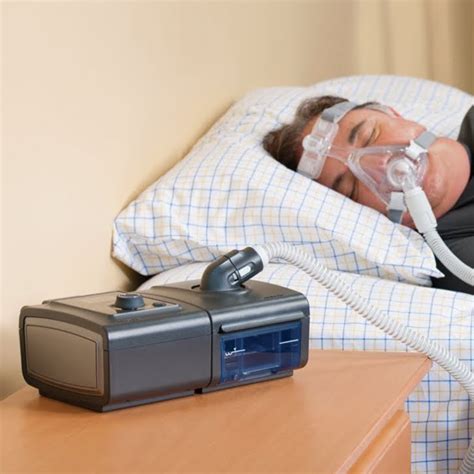
Bipap therapy works by delivering two different levels of air pressure into the lungs, one for inhalation (IPAP) and a lower pressure for exhalation (EPAP). The IPAP pressure helps to keep the airways open, allowing the patient to breathe in more easily, while the EPAP pressure helps to prevent the airways from collapsing, making it easier to breathe out. This dual-pressure system makes bipap therapy more comfortable and effective than other forms of ventilation, such as continuous positive airway pressure (CPAP) therapy, which delivers a single level of pressure.
The bipap machine is equipped with a range of features that allow healthcare professionals to customize the therapy to meet the individual's specific needs. These features may include adjustable pressure settings, ramp time, and breath rate, as well as advanced sensors that monitor the patient's breathing patterns and adjust the therapy accordingly. By providing personalized therapy, bipap machines can help patients achieve better outcomes, improve their quality of life, and reduce the risk of complications.
Benefits of Bipap Therapy
The benefits of bipap therapy are numerous, and they can be seen in various aspects of a patient's life. Some of the most significant benefits include: * Improved sleep quality: Bipap therapy can help patients sleep more soundly, reducing the risk of sleep-related complications and improving overall health. * Increased energy levels: By providing effective ventilation, bipap therapy can help patients feel more energized and alert, making it easier to perform daily activities. * Enhanced respiratory function: Bipap therapy can help improve lung function, reducing the risk of respiratory failure and other complications. * Reduced risk of complications: By managing respiratory symptoms, bipap therapy can help reduce the risk of heart problems, stroke, and other complications.Types of Bipap Machines
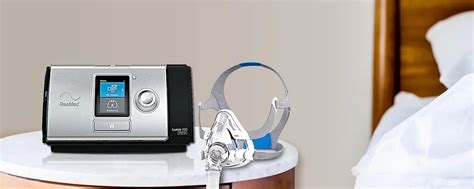
There are several types of bipap machines available, each designed to meet specific needs and preferences. Some of the most common types of bipap machines include:
- Portable bipap machines: These machines are small, lightweight, and easy to use, making them ideal for travel or home use.
- Stationary bipap machines: These machines are larger and more feature-rich, making them suitable for clinical settings or home use.
- Auto-bipap machines: These machines are equipped with advanced sensors that adjust the pressure settings automatically, providing personalized therapy and improved comfort.
- Non-invasive bipap machines: These machines use a mask or tube to deliver pressurized air into the lungs, making them a less invasive alternative to traditional ventilation methods.
Indications for Bipap Therapy
Bipap therapy is indicated for a range of respiratory conditions, including: * Sleep apnea: Bipap therapy can help manage sleep apnea symptoms, improving sleep quality and reducing the risk of complications. * COPD: Bipap therapy can help improve lung function, reducing the risk of respiratory failure and other complications. * Pneumonia: Bipap therapy can help manage pneumonia symptoms, improving respiratory function and reducing the risk of complications. * Respiratory failure: Bipap therapy can help manage respiratory failure symptoms, improving lung function and reducing the risk of complications.Contraindications for Bipap Therapy
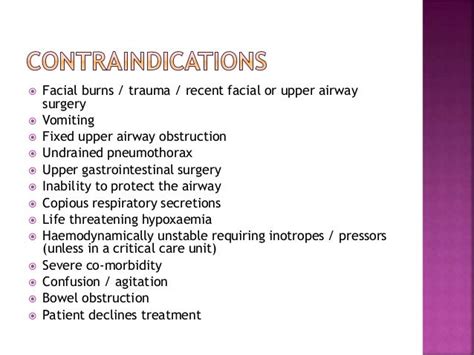
While bipap therapy is generally safe and effective, there are certain contraindications that need to be considered. These include:
- Uncorrected pneumothorax: Bipap therapy can worsen pneumothorax symptoms, making it essential to correct the condition before starting therapy.
- Recent facial or nasal surgery: Bipap therapy can interfere with the healing process, making it essential to avoid therapy for a certain period after surgery.
- Severe respiratory acidosis: Bipap therapy may not be effective in managing severe respiratory acidosis, making it essential to consider alternative treatments.
- Cardiac arrhythmias: Bipap therapy can exacerbate cardiac arrhythmias, making it essential to monitor cardiac function closely during therapy.
Side Effects of Bipap Therapy
While bipap therapy is generally well-tolerated, there are certain side effects that need to be considered. These include: * Nasal congestion: Bipap therapy can cause nasal congestion, making it essential to use a humidifier or saline nasal spray to alleviate symptoms. * Dry mouth: Bipap therapy can cause dry mouth, making it essential to use a humidifier or mouthwash to alleviate symptoms. * Skin irritation: Bipap therapy can cause skin irritation, making it essential to use a mask or tube that fits comfortably and to clean the equipment regularly. * Noise: Bipap therapy can be noisy, making it essential to use a machine with a silent or quiet mode to minimize disruptions.Setting Up a Bipap Machine
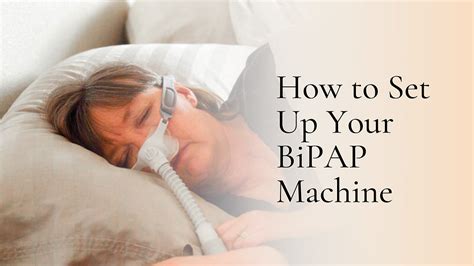
Setting up a bipap machine requires careful attention to detail to ensure that the therapy is delivered effectively and safely. The following steps should be followed:
- Read the user manual: The user manual provides essential information on how to set up and use the bipap machine.
- Assemble the equipment: The bipap machine, mask or tube, and humidifier (if applicable) should be assembled according to the manufacturer's instructions.
- Adjust the pressure settings: The pressure settings should be adjusted according to the healthcare professional's recommendations.
- Fit the mask or tube: The mask or tube should be fitted comfortably to ensure that the therapy is delivered effectively.
- Turn on the machine: The bipap machine should be turned on and the therapy started according to the manufacturer's instructions.
Troubleshooting Common Issues
While bipap therapy is generally reliable, there are certain issues that can arise. The following are some common issues and troubleshooting tips: * Mask leaks: Check the mask fit and adjust as necessary. * Noise: Check the machine's filters and clean or replace them as necessary. * Inadequate therapy: Check the pressure settings and adjust as necessary. * Skin irritation: Check the mask fit and adjust as necessary, and use a skin-friendly mask or tube.FAQs
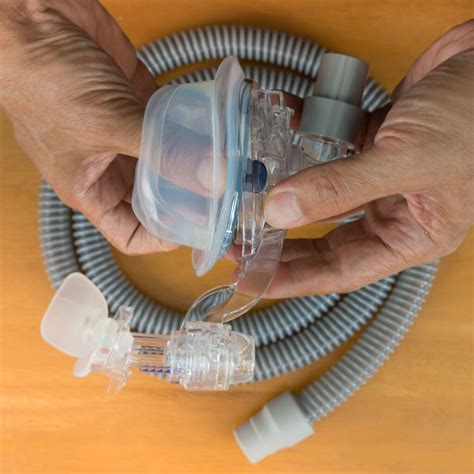
What is bipap therapy?
+Bipap therapy is a type of non-invasive ventilation that helps individuals with breathing difficulties breathe more easily.
How does bipap therapy work?
+Bipap therapy works by delivering two different levels of air pressure into the lungs, one for inhalation and a lower pressure for exhalation.
What are the benefits of bipap therapy?
+The benefits of bipap therapy include improved sleep quality, increased energy levels, enhanced respiratory function, and reduced risk of complications.
In conclusion, bipap therapy is a highly effective treatment option for individuals with respiratory conditions. By understanding the benefits, working mechanisms, and applications of bipap therapy, patients can make informed decisions about their treatment and improve their overall quality of life. If you or a loved one is considering bipap therapy, it is essential to consult with a healthcare professional to determine the best course of treatment. We invite you to share your thoughts and experiences with bipap therapy in the comments below, and to share this article with others who may benefit from this information.
